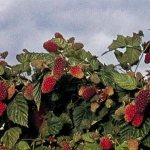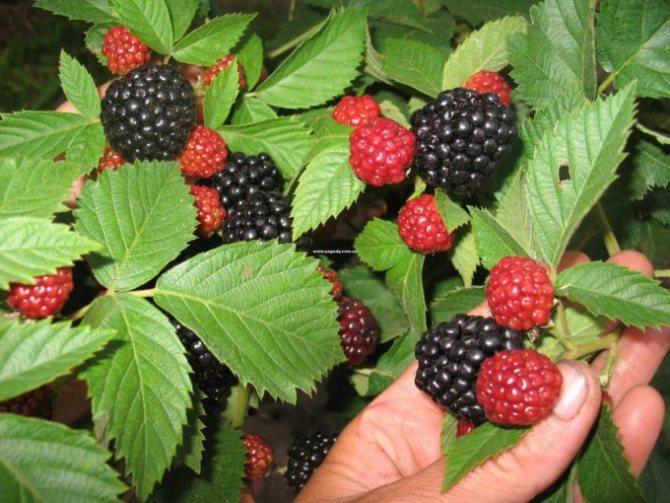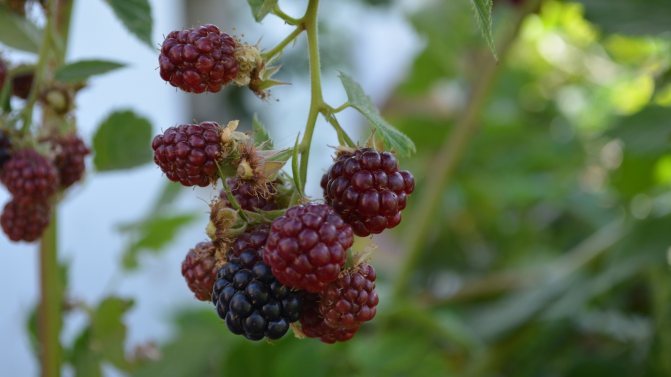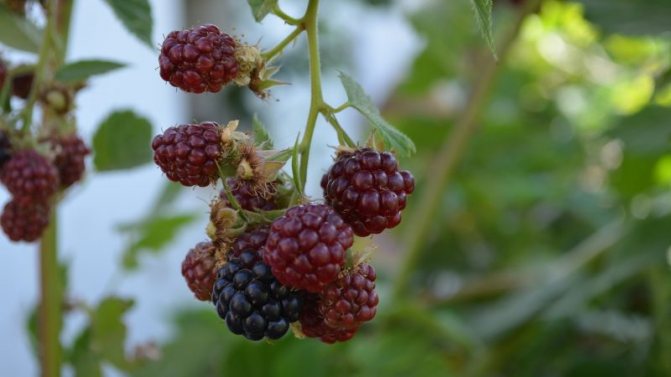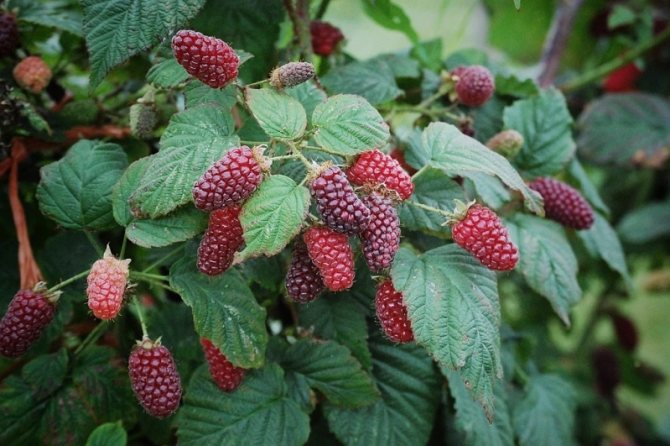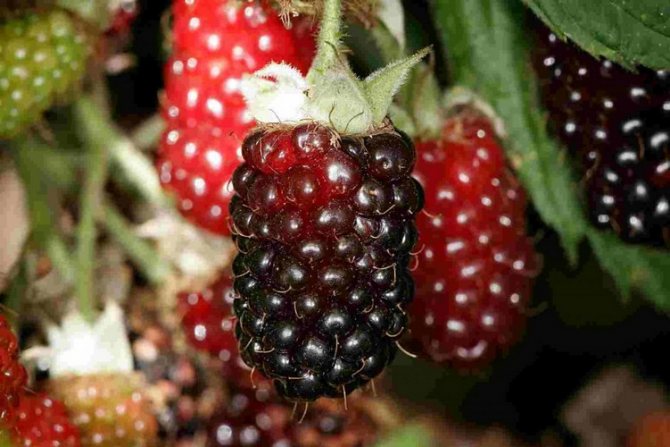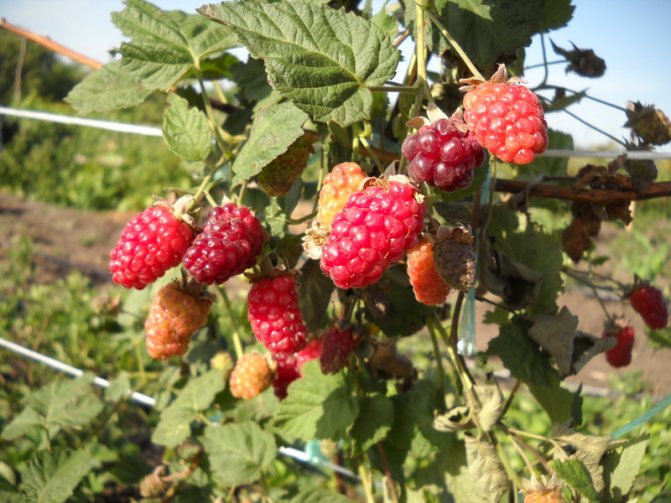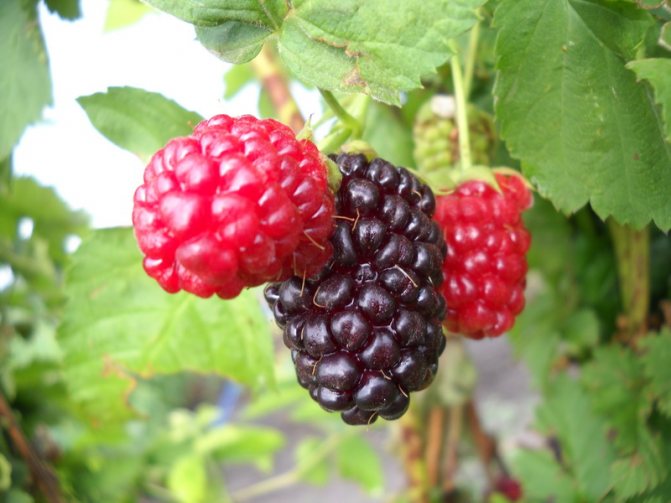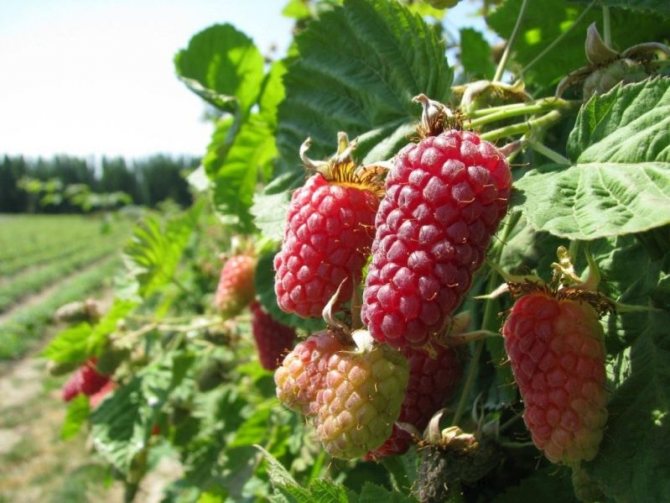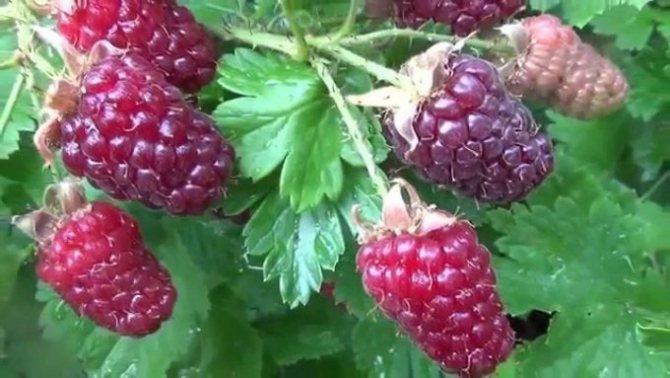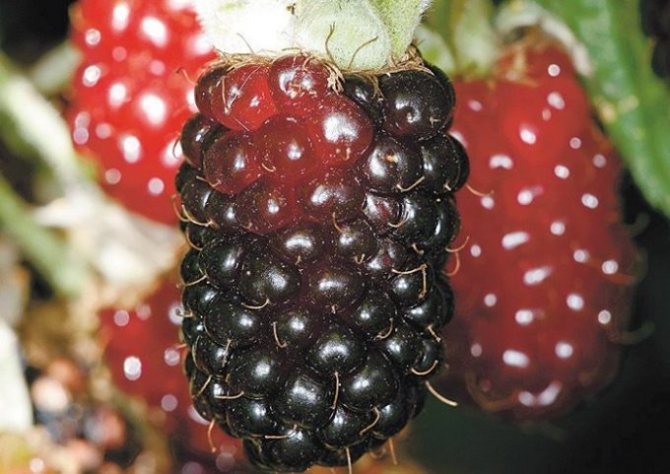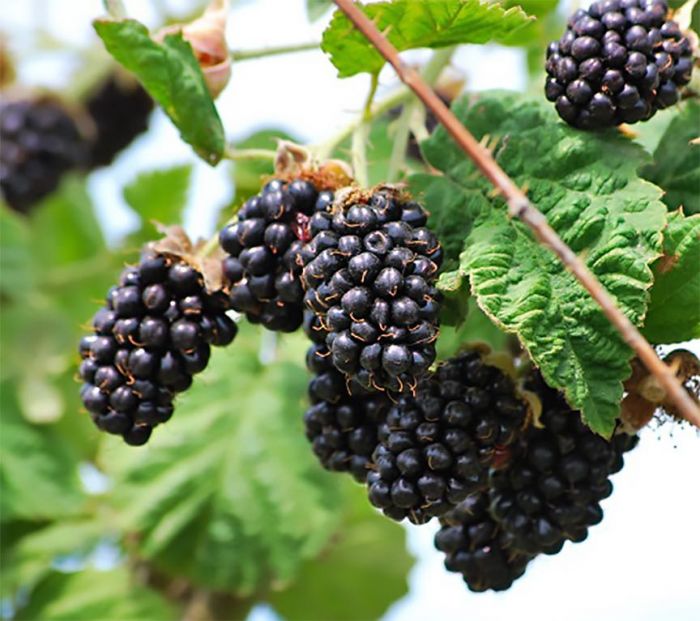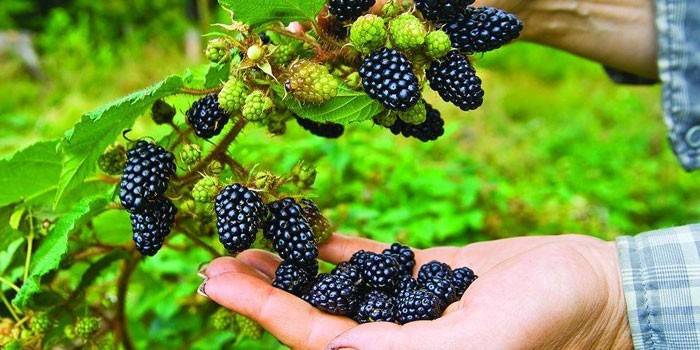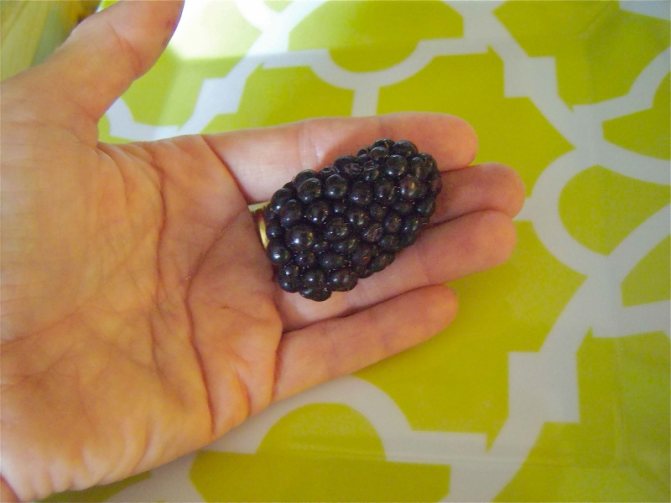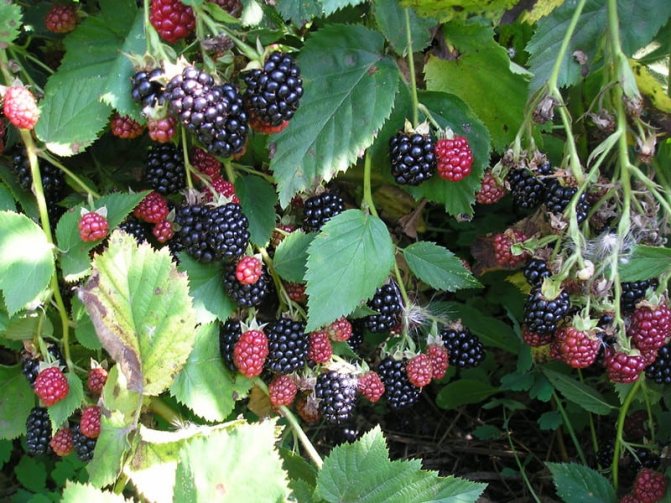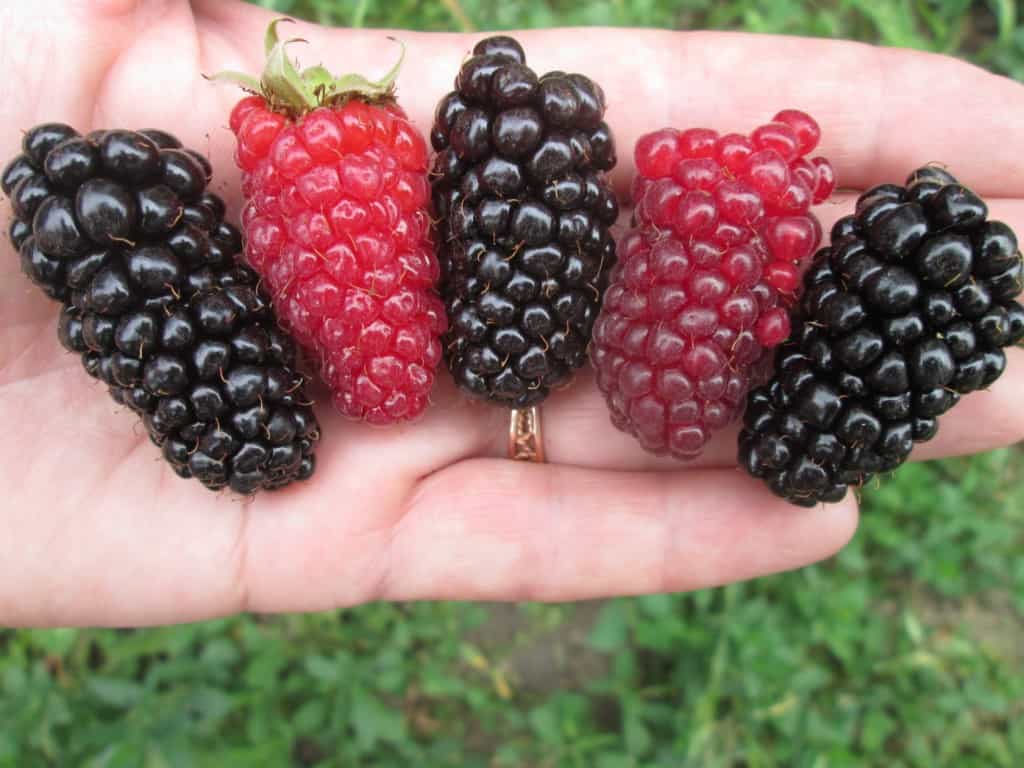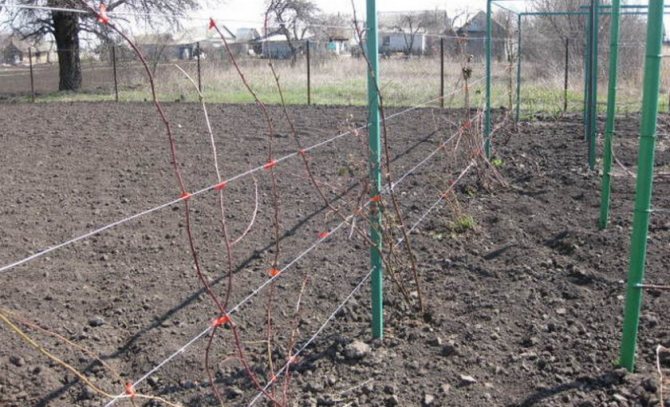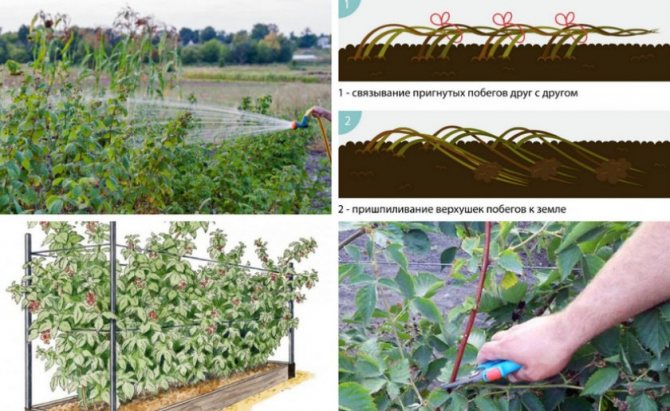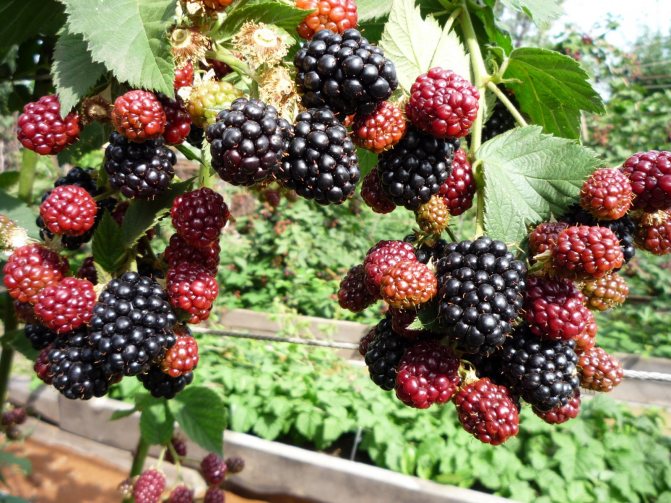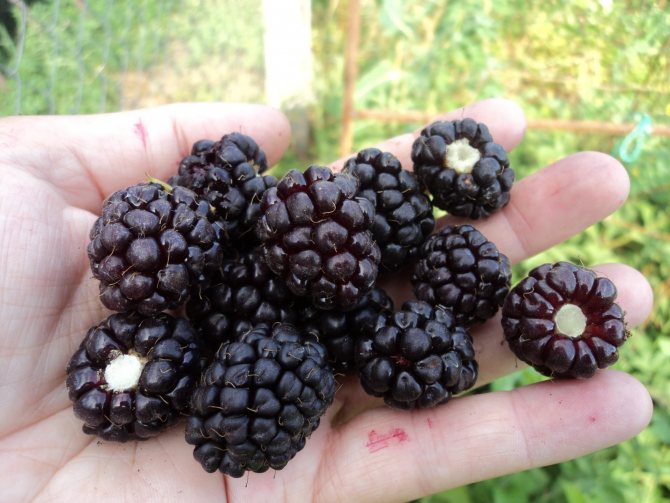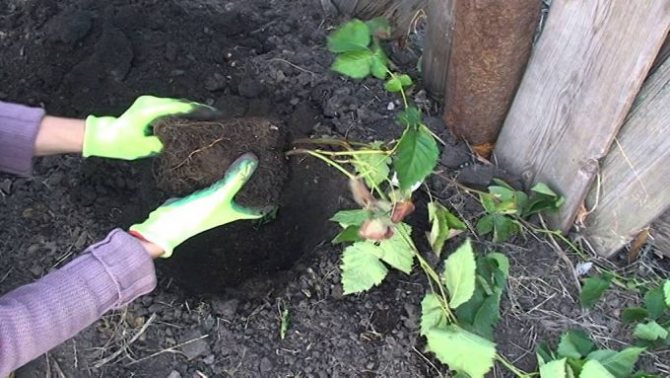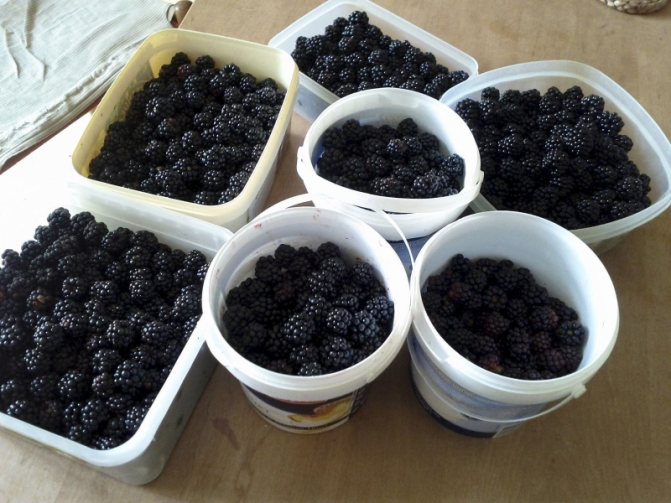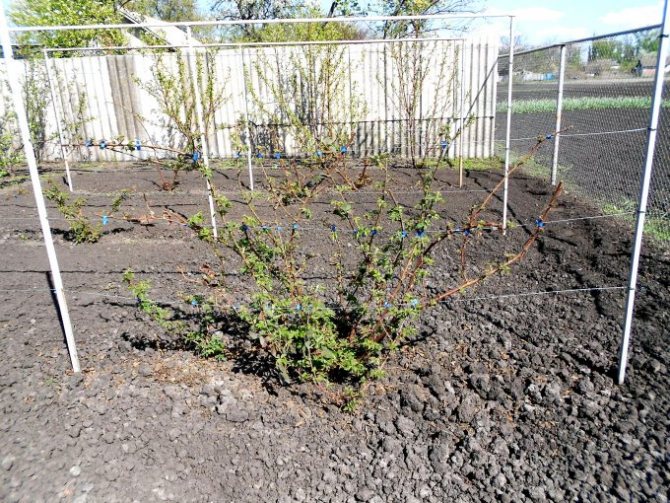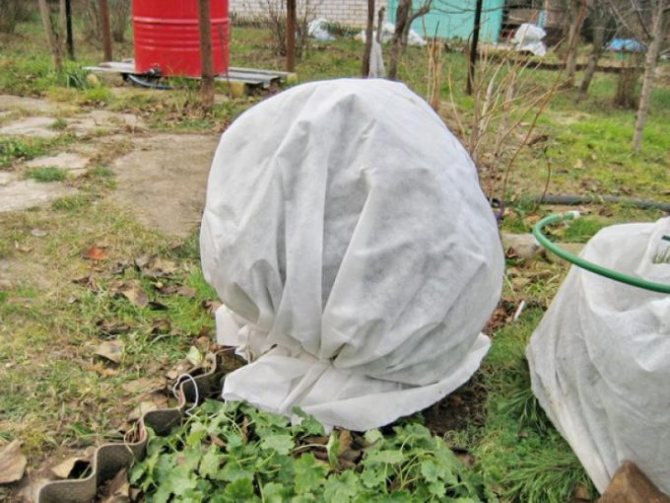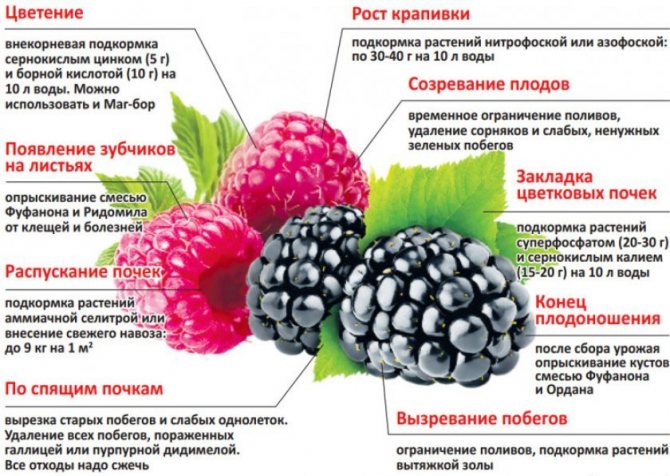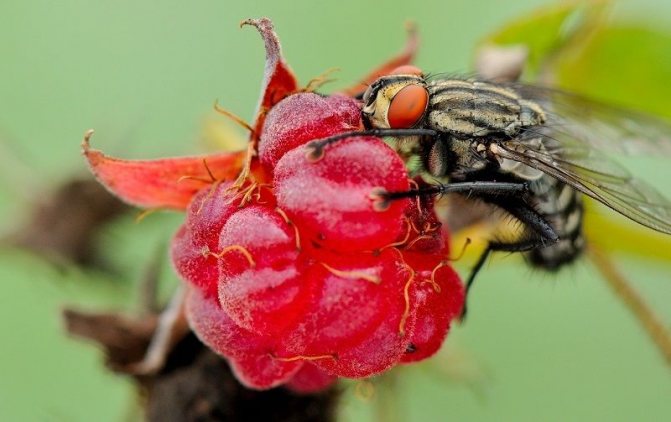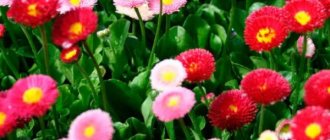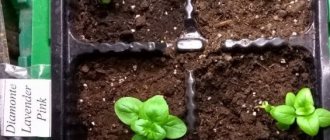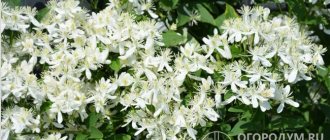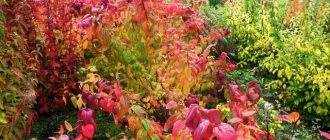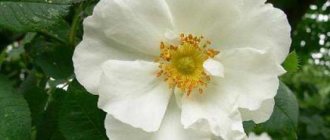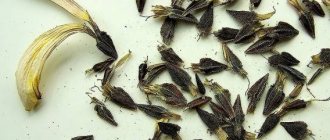Many different berries grow in our gardens. These are gooseberries and currants, strawberries and strawberries, raspberries and blackberries. But there are no limits to perfection: for the garden to be complete, you want to grow all new crops, please the eye and taste with them. For those who dream about it, there is a new variety of berries - ezhemalina. Yes, you are not mistaken, this is a hybrid of raspberries and blackberries. It would seem, why is it needed if there are ordinary berries? And in order to please you with large harvests, beautiful views and many other benefits. Are you intrigued? Well, then it is worth learning more about this interesting berry in order to start cultivating it next season.
Characteristic
A hybrid of raspberries and blackberries is called raspberry. It has the basic characteristics of mother plants. Visually, it resembles more the culture, which properties it inherited more. So, if you want to plant this plant on your site, you should familiarize yourself with the description of the varieties, reviews, photos of Yezhemalina.
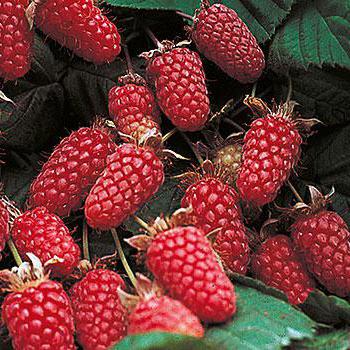
This plant was bred to increase winter hardiness, drought resistance and productivity of raspberries. At the same time, the improvement should only have a positive effect on the taste. Unfortunately, such unpretentious, undemanding hybrids were not obtained immediately. Many attempts by breeders have been unsuccessful.
At the moment, there are many varieties of jemalina. Breeders have tried to combine only the positive properties of these plants. For example, a hybrid is often a semi-spreading bush with shoots that grow parallel to the ground. Branches can also grow first upward, and, having reached a certain height, bend downward.
The plant is attractive and decorative throughout the growing season. Large flowers of pink or white color will be an excellent decoration for the garden, in contrast to the inconspicuous flowering of raspberries. Large berries of jemalina, most often of bright color, are collected in large clusters.
To the delight of many gardeners, breeders have bred absolutely studless varieties. But most of the jessalina bushes have small thorns.
This plant is drought-resistant, perfectly tolerates the lack of watering, because the root system is more developed and penetrates much deeper into the soil, unlike raspberry varieties.
Description of the variety, photos, reviews about ezemalin attract many gardeners. After all, everyone wants to collect a good harvest of tasty, juicy, healthy berries at their site.
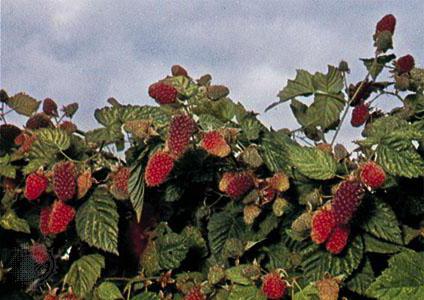

Planting dates, when is it better to plant - in spring or autumn
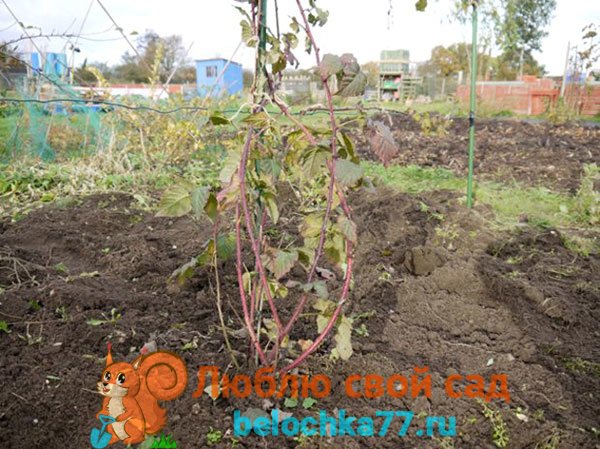

Ezhemalina is planted at the same time as most bushes. This plant has special requirements. It is believed that even in summer, bushes can be planted, but not in extreme heat. Ezhemalina is characterized by good survival rate, it perfectly tolerates different weather conditions. The main thing is to follow the general planting rules at different times of the year.
In the spring, the bushes should not yet fully wake up. And in the fall, you need to have time to plant them some time before the onset of frost, so that they have time to take root. Many gardeners point out that it is quite easy to plant the ezemalina and in most cases it takes root well.
Yield
Garden raspberries often bear fruit later and longer than ordinary raspberries. The berries have a rich and pronounced taste. They are stored for a long time, so it is easy and simple to transport the berries.
Do you want to get a good harvest from year to year? Then special attention should be paid to the care and cultivation of jemalins.
Compared to hybrids, raspberry yields are significantly lower. The plant got this property from blackberries. But the raspberry provided the plant with frost resistance, which the blackberry lacks.
Many gardeners are interested in reviews, descriptions of ezhemalina varieties. Photos of berries help you make the right choice.
Varieties of garden ezhemalina with photo
Today, ezemalina is a berry, which has many varieties that differ in the qualities of bushes, sizes, taste of berries, etc. It is worth considering some of the varieties in order to better understand the question of what constitutes ezemalina.
Tayberry
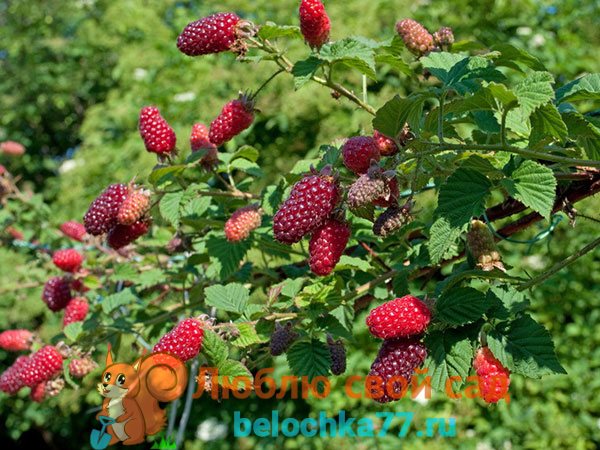

Tayberry variety
This variety was bred by breeders not so long ago. Its main characteristic is its excellent yield. The plants themselves are quite thorny, and the berries have a dark red hue, large in size.
Loganberry


Loganberry variety
Feature - the absence of thorns and creeping branches, like a blackberry. The berries are red in color, but when ripe they darken significantly. One piece can weigh up to 5 g and reach more than 3.5 cm in length. Sourness is also present in the taste, ripening occurs early.
Boysenberry


Boysenberry variety
This variety is also characterized by creeping bushes. The variety represents different plant forms - thornless and thornless. The berries are oval in shape, large enough, brownish in color. Their taste is closer to blackberries than to raspberries.
Texas


Variety Texas
This variety is characterized by very large berries - up to 12 g in weight. They are elongated. The bush grows up to 5 m, but it does not stretch in height, but spreads. The plant tolerates frost well, especially when compared to other varieties. There are thorns on the bushes. The berries are more like raspberries, their taste is sweetish with sourness.
Darrow
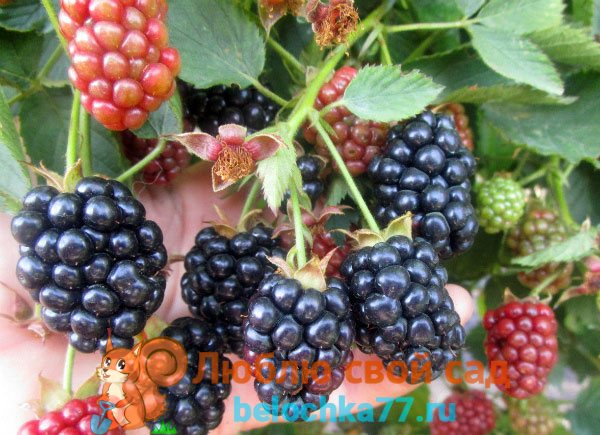

Darrow variety
And this variety is already growing upward, reaching 3 m in length. It tolerates frost perfectly, has thorns. From a sufficiently mature plant, about 5 years old, up to 10 kg of the crop can be removed. Sweet and sour berries are medium in size, weighing up to 4 g.
Loganberry variety
This variety is considered to be the first hybrid of blackberries and raspberries. American breeder Logan at the end of the 19th century worked on the development of a new variety of blackberries. By chance, there was a cross-pollination of blackberries with raspberries growing nearby. The result is a variety that is unpretentious in cultivation and yields a good harvest.
The plant is thorny, has creeping shoots of medium length. The bush does not produce root suckers, but if they are damaged, root shoots will appear. The number of shoots for replacement is insignificant, but increases over time.
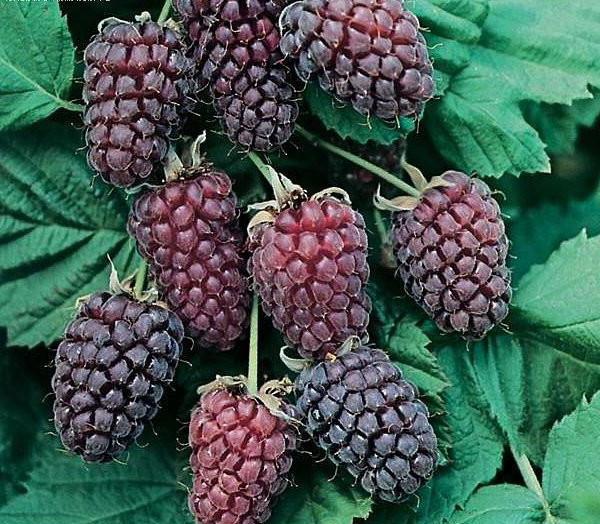

Berries of a red-violet hue, elongated, ripen unevenly. The diameter of the berry is on average 2 cm, length - 4 cm, weight - 8 g. Taste - sweet and sour with raspberry aroma.
The crop ripens early, like raspberries. Various varieties of this variety exist today. Thornless Loganberry, for example, is a thornless plant with sweeter berries that ripen in late summer.
Due to its resistance to frost, this variety can be grown in central Russia.
Growing features
The cultivation of raspberries is practically the same as for raspberries, with some minor differences. Fast growing shoots of the shrub must be tied up regularly, otherwise they will spread uncontrollably throughout the garden. Although the ezhemalina bushes are considered an unpretentious plant, it is better to choose well-lit places with loose soil for planting it on your site.
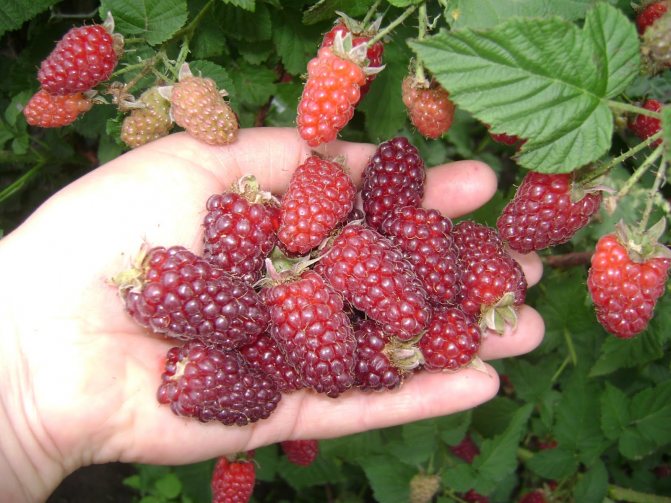

Tayberry variety
Looking for a good variety? Pay attention to the description, photo, reviews of the "Tayberry" variety.This plant is vigorous, with powerful creeping shoots, which turn into a burgundy color as they ripen. Small rare thorns are present on the shoots.
Fruiting occurs in August. The berries are dark red, weighing 5-10 g, with a sweet and sour taste, similar to blackberries.
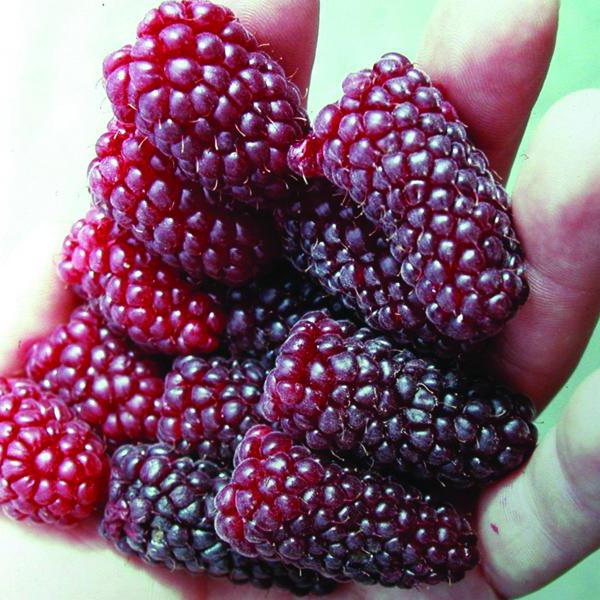

This variety is absolutely not picky about the composition of the soil. Therefore, many gardeners appreciate it. In addition, the plant shows resistance to various diseases and tolerates drought well.
The closest relative of this variety is Tummelberry, which is a more frost-resistant variety. But remember that these plants still need insulation for the winter.
The main disadvantage of this variety is the property inherited from the blackberry - the presence of small thorns on the branches and poor separation of the berries from the stalk.
Pruning and shaping
To increase crop yields, the bushes must be pruned annually. The first period begins at the end of May - the first half of June. One-meter shoots are pruned by 10-15cm. Then these shoots will branch better. The second period begins in the second half of summer after fruiting. At this time, the fruiting shoots are cut out entirely. It will not be superfluous to thin out the bush, leaving only 8-9 shoots on it. In the spring, you will need to carry out another thinning and leave 4-6 of the strongest shoots.
You can remove the harvest from the bushes in the second year of their life.
Boysenberry variety
Boysenberry is one of the popular varieties. It is a drought-resistant plant with creeping shoots. There are 2 types of varieties: with and without thorns.
Berries are large, up to 5 cm in length, weighing up to 10 g, brownish-cherry color. When fully ripe in July-August, the berries become almost black. They have a pronounced blackberry aroma, pleasant sweet taste with a slight sourness.
The yield is small: up to 5 kg of berries can be harvested from an adult bush.


Agrotechnics
As soon as we got acquainted with the wonderful qualities of the ezemalina, it was time to find out how to keep it in the garden. Its cultivation is in many ways similar to the cultivation of common raspberries.
The place where the ezemalina grows must be protected from the northerly winds and be under the sun.
When planting this crop, manure and compost should be excluded, since they provoke shoot growth and increase yields in the first year. It is not bad if you do not want to grow jemaline for more than one season. If not, then remember that it is the abundant growth of shoots and high yields that make the plant defenseless against the winter cold. Mullein and poultry manure solutions should only be used two years after planting.
Variety "Texas"
"Texas" is a plant with long creeping shoots up to 4 m. From one adult bush of this variety, you can collect about 6 kg of tasty, dark red berries. Plants bear fruit for over 15 years.
The berries have a sweet and sour taste, and as they darken, they become tastier. Fully ripe, dark berry has practically no sourness. There is a blackberry aroma.
The plant is not afraid of harsh winters and rainy cool summers. This variety of ezhemalina bears fruit well and grows in the Middle lane.
The disadvantages include sharp thorns and poor separation of the stalk from the ripe berry.
More about jemalina berries
Accidental crossing of the two berries helped to obtain only the first variety of jemalina. Scientists have adopted this experience and continued to select a new berry. The hybrid bush is a sprawling plant that grows parallel to the ground. As the branches grow, they rise straight up, and then begin to tilt.
Ezhemalina is decorative during its active growth. It blooms in large flowers, white or pink. At this time, the buds are collected in large inflorescences.
On some varieties, there are thorns, but breeders have actively worked to create varieties of berry crops without thorns. Such bushes are not afraid of drought, so if they are not watered for a long time, then this practically does not harm the plant. The fact is that the root system of the bushes is more developed, to which raspberries penetrate into the deep layers of the soil.
The plant is not too hardy. It needs preparation for winter so that it is not damaged by cold winds. It is best to plant this crop in the southern regions of the country. Planting is carried out in the spring or fall months. If the climate is too hot, then the bushes need to be watered from time to time.
For colder regions, Darrow and Tayberry varieties are suitable. They have frost resistance suitable for a harsh climate, and berries ripen on their bushes early. In general, this crop is not well prepared for cultivation in the northern area. But with the experience of growing berry crops and the correct selection of the variety, it is possible to grow a culture under such conditions.
Youngberry and Sunberry varieties
These are late-ripening varieties. Shoots with thorns. The berries are dark red with a slight sourness. The crop can be harvested before the first frost. Many people use these varieties to create a hedge in their personal plot, they can become a real decoration of the garden.
At the moment, there is a wide variety of ezemalina varieties. Sometimes the difference between them can be significant, so every gardener will be able to choose the variety that suits him.
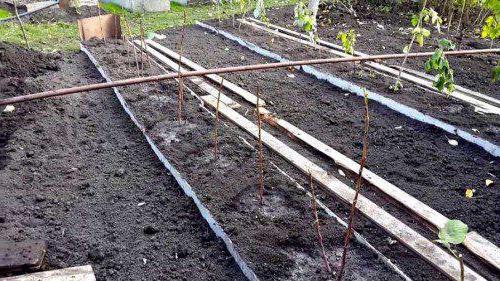

The nuances of cultivation and care
If you correctly choose a site for planting bushes, then care and pruning of black raspberries will not cause any significant difficulties. The area should be well lit by the sun and have reliable wind protection.
This will eliminate damage from glaciation and minimize the drying out of the stems in winter. The roots of black raspberry are characterized by deep penetration into the earth's thickness - they do not reach the groundwater by 50 cm. Therefore, the culture is not demanding for the type of soil. But he does not disdain timely watering and dressing.
Despite the drought tolerance and insensitivity to pests, viral diseases can cause great harm to bushes. Therefore, it is not recommended to plant black raspberries where potatoes or tomatoes grew. It is better to plant it away from these places, and also remove it from red raspberries. Black raspberries have one property - the formation of strong lateral processes on one-year stems (up to a meter long). A considerable part of the harvest is concentrated on them. Black raspberries are propagated by apical cuttings or leaf cuttings.
Otherwise, caring for black raspberries is identical to red. Due to the strong development and thickening of the bushes, the seedlings are placed at a distance of 1 meter from each other. And since the stems reach 2 m in height or more, then a garter to the trellis will not be superfluous for them. Spring pruning of Cumberland raspberries is designed to shorten the lateral processes on the stems, on which up to 6 buds are stored.
Regular pruning of Cumberland black raspberries in the fall will make it possible to create an excellent decoration of a summer cottage from seedlings, like a hedge. For which it is necessary to fix the stems on the sunny wall of the house or on the fence. In another case, in order to relieve the load from the branches, a wire support is designed. For this, wooden columns are installed at the edges of the row (2 - 2.5 meters high). A strong wire is attached to them at three levels - 0.5, 1.8 and 2.1 meters.
Planting a plant
Ezhemalina is an unpretentious plant. It can be grown on any soil, but loose, fertile, moderately moist soils are best suited. It is advisable to choose areas protected from the wind.
The planting of the ezemalina can be done in spring or autumn. When planting vegetative seedlings, it is necessary not to damage the clod of earth.
The bushes are recommended to be planted in rows at a distance of 80 cm from each other. Between the rows there should be 1.5-2 m. With a denser planting, the plants will not have enough sunny color, this will affect the quantity and taste of the crop.
Before planting, it is necessary to prepare pits 40 x 40 x 40 cm. The extracted soil must be mixed with humus. It is not recommended to use chicken manure, because a large amount of organic fertilizers causes increased growth of the bush, but negatively affects winter hardiness.
Having placed the seedling in the hole, it is necessary to carefully spread the roots and cover with prepared soil. The soil is watered abundantly. Top up the soil if necessary.
How to plant a shrub correctly
First of all, you need to decide on what scheme the planting will be carried out: single bushes or rows. Growing according to the first option requires individual support for each plant, in the second case, shoots can be launched along the trellises. Choose a sunny, ventilated place for bushes where the groundwater does not lie too close to the ground. In damp areas, drain well.
Planting begins in the spring when the snow has melted and the ground has thawed. For small seedlings, you can dig holes with a diameter and depth of 40 cm. If the ezemalina is already large, navigate by the root system - it should fit freely into the dug hole. The distance between the plants should be at least a meter, and between the rows - 2 m. Put pebbles for drainage and organic fertilizer on the bottom. For backfill, mix the soil with potash-phosphorus fertilizers. If growing on acidic soil, add ash or dolomite flour.
Water the seedlings and cut off the shoots so that their length does not exceed 30 cm. To make caring for the bushes easier, you do not have to fight weeds, cover the ground between the bushes with cardboard. Any mulching material can be poured onto it all summer. After a year, the leaves will rot and turn into fertilizer.
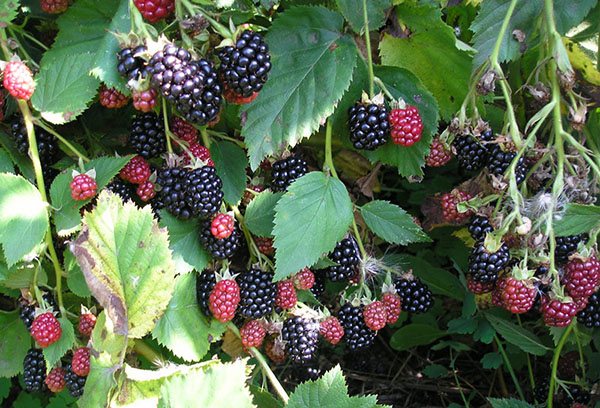

Preparing for winter
All plants must be prepared for wintering. All shoots that have reached a length of 2 meters in a year should pinch the tops. This improves the branching of the plant. With long side shoots, a similar manipulation can also be carried out.
In regions with cold winters, shoots are not cut, but insulated. How to shelter ezemalina for the winter? It is enough to untie the shoots from the trellises and lay them on the ground. A variety of covering material is laid on top. Leaves, burlap, straw, peat are used as insulation.


Pruning ahead of frost
What does the pruning of black raspberries give in the fall before the arrival of cold weather? This procedure allows you to make thickets less often and get an abundance of berries next year. At the same time, they will retain their excellent taste characteristics and will be large. Planting and caring for black raspberries is not so difficult - pruning the bushes in this matter plays a key role. Indeed, it is thanks to this procedure that harmful insects are distracted from planting, and the appearance of unpleasant diseases is prevented. At the same time, young shoots acquire the necessary reserve of strength for wintering, which helps them not to die before the onset of heat.
Also, pruning of Cumberland raspberries in the fall is required to eliminate two-year shoots after the fruiting phase. The shoots of the first year retain up to 30-50 cm from the surface of the earth, removing excess length. An important point is the competent preparation of the bushes for winter. For this, the stems of black raspberries are fixed at the soil surface (not very low) using metal staples (or wire). It is not required to additionally cover the plants. Since the frost resistance of the variety allows it to tolerate well even the warmest winter under the snow cover.
Reproduction of ezhemalina
Seed germination in hybrids is quite high, but not all seedlings grown from them retain the properties of the parent plant. Therefore, most often, the reproduction of ezhemalina occurs by layering and cuttings.These are the most effective ways to grow jemalberries. Seedling care is just as important as it is for an adult plant.
During autumn pruning, small twigs with 1-2 buds can be rooted in a pot or directly in the open field. It is advisable to create greenhouse conditions at least temporarily. To do this, the cuttings can be covered with a jar. You should also make sure that the soil is constantly moist. In spring, rooted shoots can be transferred to a permanent growth site. Experienced gardeners claim that lignified cuttings are also suitable for reproduction of the jagged tree. They take root very well.
Reproduction by layering is also easy. To do this, in the spring, you need to dig in young shoots to a depth of 20 cm. The shoot itself must be pressed down from above. This area must be well watered throughout the summer. By the fall, they will take root in several places. You just need to cut the shoot into several young seedlings and plant them in a permanent place of growth. But it is better to postpone the transplant until spring. Until this time, it is undesirable to cut off the layers from the mother plant.
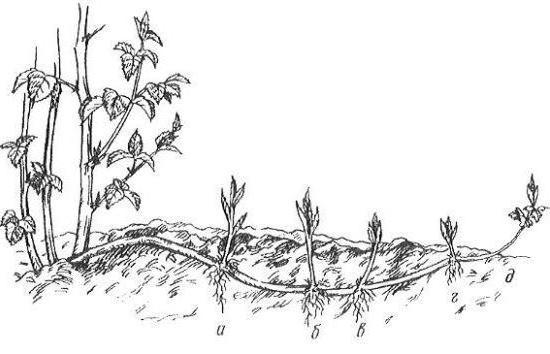

Sometimes gardeners propagate this plant by root cuttings. To do this, in the spring, they take the roots of an adult plant, cut them into pieces of 10 cm. They are planted separately from each other, watered and loosened the soil. After a certain time, a new plant will grow from such cuttings.
Choosing a place and planting ezhemalina
The place for ezemaliny should be sunny and calm. If the bushes grow in the shade, they will quickly begin to wither, and the harvest will be much worse. The soil should be fertile and aerated so that moisture does not stagnate.
Fresh articles about garden and vegetable garden
The best time for planting a hybrid is late September - early October; in the southern regions, the dates are extended until the end of October. Dig holes for seedlings the same as for raspberries (40/40/40). The distance between the bushes should be about a meter.
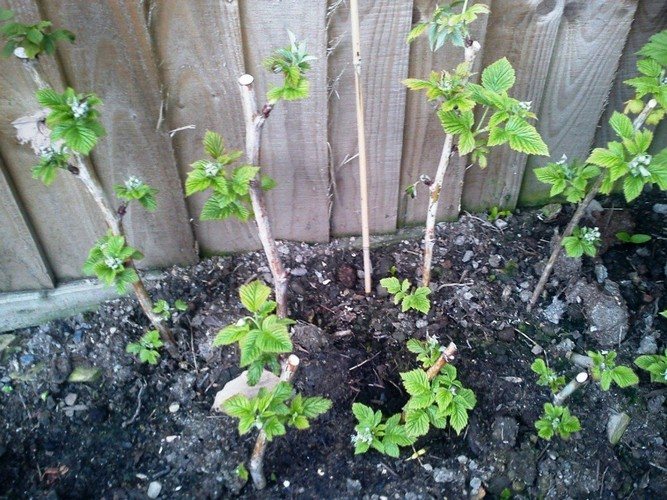

Diseases and pests
Most often, hybrids do not produce root growth. Thanks to this, the time spent on caring for the plant is significantly reduced. Many gardeners are interested, and what kind of diseases and pests are scary every day? Breeders claim that this plant is resistant to several fungal diseases that often threaten raspberries and blackberries.
Sometimes on varieties "Boysenberry" and "Youngberry" you can find verticillosis or powdery mildew. But for the "Loganberry" variety, these misfortunes are not at all terrible. But here "Loganberry" and "Youngberry" are susceptible to the development of rust, and "Boysenberry", on the contrary, shows excellent resistance to this disease.
Breeders claim that there are varieties that are resistant to almost all diseases.
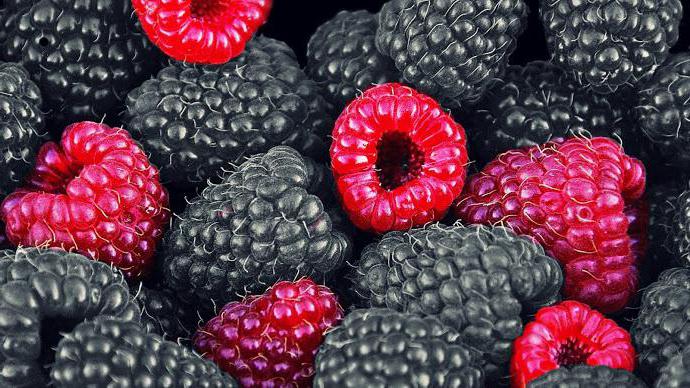

Benefit and harm
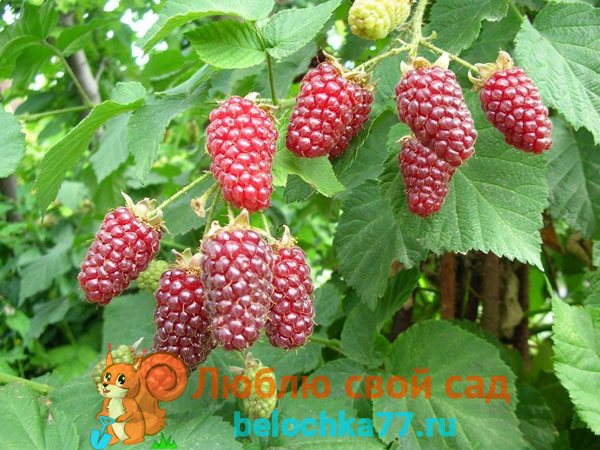

Jemalina berries have a rich chemical composition, which makes them useful for the human body. Anti-inflammatory and antipyretic properties cause the use of berries for acute respiratory infections, fever and pneumonia. Yezemalin has a positive effect on the intestines, nervous system, joints and kidneys. The berry is useful for alcohol or heavy metal poisoning, for cystitis. By the way, not only berries can be beneficial, but also pouring, bush branches.
However, there are also contraindications for the hybrid berry. Juice from it can not be drunk by those who suffer from acidity, gastritis, ulcers. Urolithiasis, gout, kidney disease and diabetes mellitus, as well as nasal polyps and bronchial asthma are all diseases in which it is recommended not to abuse ezemalina. The risk of an allergic reaction determines the careful use of the berry for allergy sufferers and pregnant women.
Why you need to cut raspberry shoots
Novice gardeners are tormented by the question of whether to prune raspberries in the fall. We answer: if you leave the shoots of the plant in full growth, then a decrease in yield and a decrease in berry size are guaranteed.Remaining dry shoots do not allow young shoots to grow. Pruning is required for all varieties of raspberries and promotes the appearance of new shoots in the place of those that bear fruit. Plants over two years old are best removed.
Dense thickets directly affect the yield: a lot of greens - few berries. This also affects the taste - the sweetness disappears, giving way to a sour taste. Numerous pests do not deny themselves in the fragrant raspberry forest, which bring various diseases for the plant with them to a new place of residence. Young shoots, which are a consequence of the lack of pruning, do not have time to ripen and die even before the arrival of spring.
Description and useful properties
Such an unusual berry includes many beneficial properties of two types. There are a lot of advantages in stock:
- unusual taste;
- high productivity;
- large berry size.
Since raspberries easily tolerate frosts, and blackberries grow in almost any soil, the care of ezemalina turned out to be very simple. She is not picky about weather conditions and land, which is a big plus. This berry has practically no thorns, which makes harvesting easier.
There are a lot of useful properties and vitamins. Basic nutritional value:
- vitamins of group B, C and E;
- iron, phosphorus, copper and magnesium;
- carotene, pectin and organic acids.
The calorie content of blackberries is 34 calories per 100 grams. These berries are very useful for the whole body, and they are allowed to be consumed in fairly large quantities. 100 grams contains 1.5 grams of protein. The main composition is water.
The raspberry-blackberry hybrid is widely used in folk medicine. Broths help with problems with the immune system, kidneys and liver. It is also an excellent antipyretic agent.
A decoction of green berries will help out with diarrhea, and from ripe berries it is widely used as a laxative.
Ezemalin contains a lot of calcium: it will help with joint pain, strengthen the capillaries and is an antiseptic. It is also not replaceable in the fight against sclerosis.
These fruits have many beneficial properties and will be beneficial to everyone. No contraindications are known, berries should not be consumed only in case of allergies.
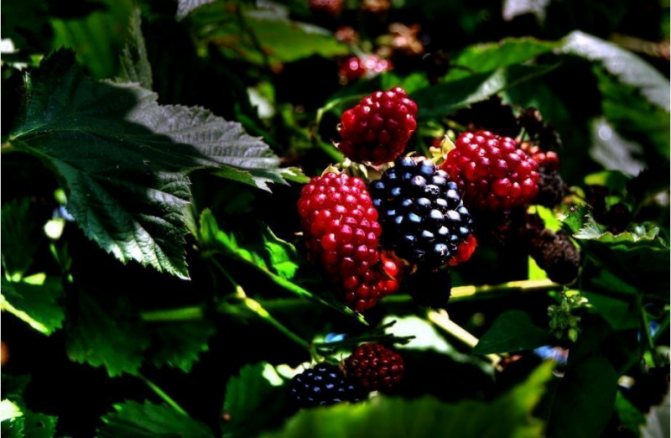

Garter bushes
Since ezemalina has the ability to grow rapidly and the stems of some of its varieties can reach 4 m in length and 25 mm in thickness, it is recommended to grow the plant on a trellis, gradually tying up powerful branches as they grow.
It is recommended to use a flat trellis with a height of 2–2.5 m. To do this, you can use vertical supports, between which 3-4 wires are pulled at different heights. Fruiting stems are attached to the upper tiers of the trellis in the form of a snake, the rest of the stems are attached to the lower wire.
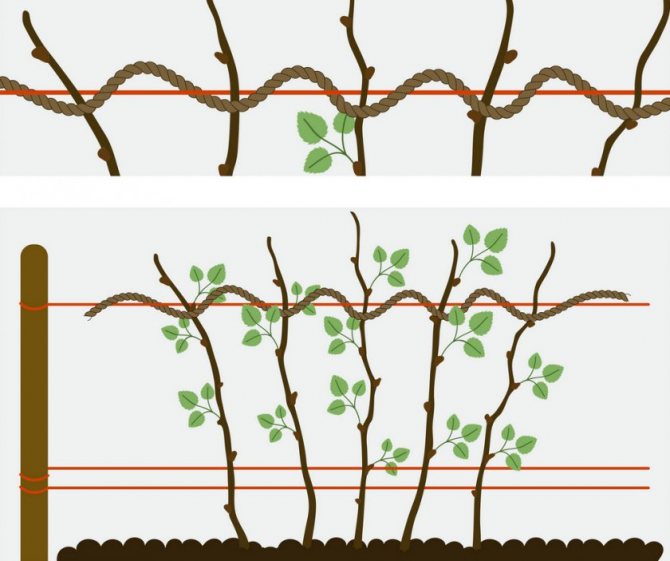

In the process of ripening on a trellis, the berries receive a sufficient amount of solar heat and have good air access.
Autumn care
In general, ezhemalina is a frost-resistant plant, but this does not mean that it does not need additional procedures that will help strengthen its resistance to winter. Before leaving for the winter, shoots are removed from the trellises, laid along and covered with organic matter. In the trellis, it is necessary to pull at least 5 rows of wire (line). The lower shoots are tied to the lower rows, the upper large shoots are fixed on the upper rows of wire. It is not recommended to fasten the plant to the stakes. The berry becomes smaller, and the plant itself grows in different directions. Without tying up the ezhemalin, in a year or two, it will quickly fill the entire area uncontrollably. If you live in an area where there is a lot of snow in winter, abundant precipitation, then such shelters with organic matter can not be carried out, the snow cover and drifts will replace the shelter and warm the plant.


Top dressing. Ezhemalina varieties are demanding on nitrogen. You can use nettle infusions, diluted manure as top dressing.If there are no such components, then you can feed with urea.
Recommendations for buying seedlings
Yezhemalin has not yet received widespread distribution. It's good if your neighbors have already acquired such a plant - you can ask for a seedling. Seedlings are often sold through websites on the Internet. But when buying, take into account some subtleties: do not order goods from a company located thousands of kilometers from you, because the climatic conditions there may be different. Also, the shorter the path the seedlings make, the better they will survive and take root successfully. The best option is to buy in specialized centers or nurseries.
Benefits of a hybrid shrub
The plant reflected the best properties of both representatives of berry bushes, the negative characteristics were muted:
- The new plant, unlike the blackberry, is winter-hardy, capable of developing in the conditions of the northern regions.
- Drought resistance of the culture is higher than that of raspberries.
- The hybrid has a high and stable yield (an adult bush yields up to 9 kg). Fruiting several times a season, before frost. Ripening is uneven.
- The new culture is not susceptible to infections, it resists most pests.
- The plant tolerates the choice of soil (in comparison with the capricious raspberries).
- Easy care. The hybrid does not require constant watering. It does not spread over the site, since it practically does not give overgrowth.
- Fruit transportability is good.
- The variety is used by designers to create compositions in the garden. The shrub can function as a hedge.
The life span of a new variety reaches 15 years.
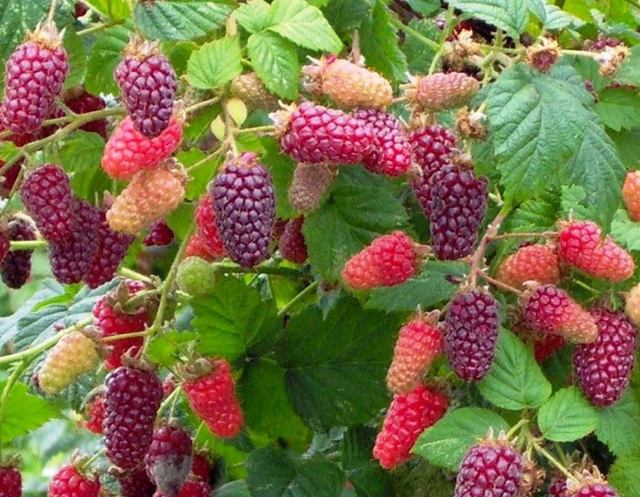

How and when to prune raspberries in spring
Spring pruning should be completed before the main sap flow begins. They focus on the arrival of spring in their region.
Frozen, broken shoots must be cut to a healthy bud.
TIP!
(click to find out)
The next stage of pruning is the emergence of mass shoots, which are removed under the root with a shovel. If you plan to leave a few for fruiting next year, then choose sturdy and strong ones.
Please note that if you do everything right in the spring, then in the fall there will be 16-20 healthy young shoots on the ridge meter.
Types of black raspberry pruning
It is highly undesirable to neglect such a procedure as pruning the jemaline. If you forget about it, then the bush will thicken, which will affect the yield in the next season.
There are several types of this procedure. Each one depends on the chosen season and the tasks facing the gardener. Blackberry-like raspberries can be cut up to two times a year. This is usually done in the summer (pruning black raspberries after harvesting) and at the end of autumn when the air temperature drops to minus marks. It is possible to perform the procedure in the spring.
In the process of summer pruning, carried out after fruiting, the apical part of the stems is removed, leaving the bottom part of 1.7 meters. These manipulations should ensure the accelerated development of young processes. The number of the latter in this case can be 6-8 pieces.
Gardeners reviews
Nina Sergeevna, Moscow
We had ezhemalin. Specially bought, some sort of varietal. But the berries have never been seen. Now we no longer have it. I don’t know what was wrong with her. Our raspberries grow well both garden and forest. And I haven't seen blackberries in the forest either, and on our site it also develops poorly and bears fruit.
GOST 385147
Yezhemalina Tayberry is quite winter-hardy and unpretentious, grows well on any soil, and is fruitful. In addition liana raspberry - blackberry hybrids are highly decorative and can be used in the decoration of the garden plot.
Things to remember
- Distinguish the variety. Depending on the variety, ezhemalina is characterized by frost resistance, immunity to diseases, productivity, presence of thorns, taste and color of berries.
- Look after. Care and cultivation of zemalina consists in timely watering, preventive treatment for diseases, garter and pruning of bushes.
- Propagate by root layers or shoot tops. The easiest way to reproduce is by the tops of young shoots.
Cooking recipes
Storage tricks do not differ from the methods known for other berries. Fold ezemalina carefully in a small container. To prevent the fruits from spoiling quickly, they must not be washed. Store it in the refrigerator or freeze it properly.
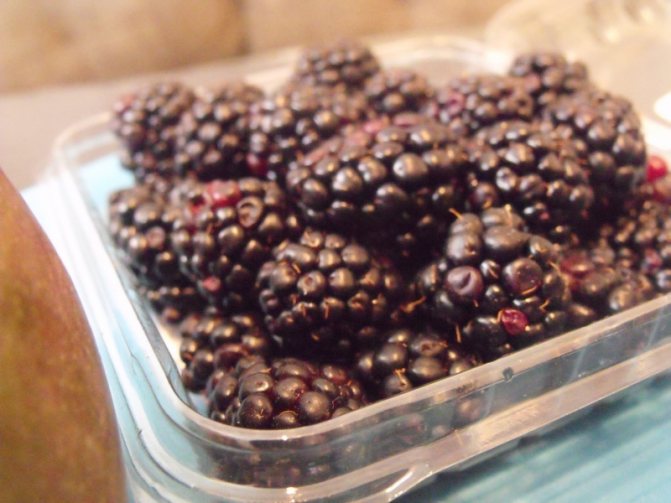

For freezing, berries are sorted out and placed in one layer on a pallet. Already frozen fruits are poured into a bag and hermetically closed. Store only in the freezer. This is the simplest sugar-free freezer.
There is also a second freezing method. Dry berries are mixed with sugar 1 to 1. Then they are laid out in bags and in the freezer.
If the berries are purchased, they are freed from pesticides by soaking.
There are a very large number of recipes from these berries. It turns out very tasty jam and compote, added to pastries and desserts, or eaten directly from the bush.
Blackberry jam
Blackberry jam is a very unusual delicacy that is loved by both adults and children. For cooking, choose ripe, but not overripe berries. The fruits are sorted out, and substandard berries are selected. Then ezemalina is put in a colander and immersed in water. Washing under running water is not recommended, as the berries are damaged. After the water has drained off, put the oil in a bowl.
Fall asleep 1 kg of fruit 1 kg of sugar and leave for 5 hours. All the juice that has formed is drained and boiled. The berries are added to the resulting syrup and boiled over low heat for several minutes. The jam is ready.
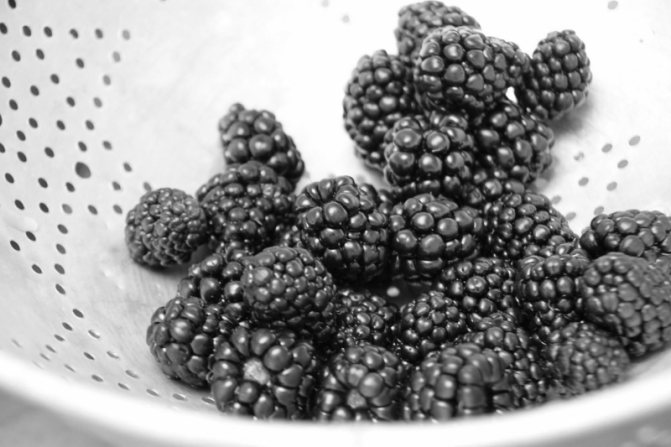

Why cut raspberries and is it necessary to do it in the fall (for the winter)
The goals of pruning any raspberry, including autumn, are:
- thinning plantings so that the bushes are better ventilated and get more sunlight;
- increased productivity (fruiting);
- prevention of wintering of harmful insects and fungal diseases in the shoots;
- improving winter hardiness;
- giving the bushes a neat appearance (additional aesthetic function).


Advice! If over time raspberries are too big then it should be mandatory plant and transplant... How to do it correctly, read here.

